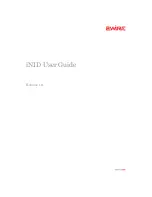
CDM-Qx Satellite Modem
Revision 6
Forward Error Correction Options
MN/CDMQx.IOM
6.5 Turbo
Product
Codec (Hardware Option)
6.5.1 Introduction
Turbo Coding is an FEC technique developed within the
last few years that delivers significant performance
improvements, as compared to more traditional
techniques. Two general classes of Turbo Codes have been developed: Turbo
Convolutional Codes (TCC) and Turbo Product Codes (TPC, a block coding technique).
Comtech EF Data has chosen to implement an FEC codec based on TPC. A Turbo
Product Code is a 2- or 3-dimensional array of block codes. Encoding is relatively
straightforward, but decoding is a very complex process requiring multiple iterations of
processing for maximum performance to be achieved.
Unlike the popular method of concatenating a Reed-Solomon codec with a primary FEC
codec, Turbo Product Coding is an entirely stand-alone method. It does not require the
complex interleaving/de-interleaving of the R-S approach and, consequently, decoding
delays are significantly reduced. Furthermore, the traditional concatenated R-S schemes
exhibit a very pronounced threshold effect – a small reduction in Eb/No can result in total
loss of demod and decoder synchronization. TPC does not suffer from this problem – the
demod and decoder remain synchronized down to the point where the output error rate
becomes unusable. This is considered to be a particularly advantageous characteristic in a
fading environment. Typically, in QPSK, 8-PSK and 16-QAM TPC modes the demod
and decoder can remain synchronized
2 – 3 dB below
the Viterbi/Reed-Solomon or TCM
cases
.
Comtech now provides the best Forward Error Correction technology currently available,
offering a very broad range of TPC code rates, combined with the entire range of
modulation types, from BPSK to 16-QAM.
6.5.2
The Evolution of TPC in Comtech Products
When Comtech EF Data first introduced the Turbo Coding option in 1999, only Rate 3/4
QPSK was offered. Further work permitted the addition of Offset QPSK operation. Two
further code rates - Rate 21/44 BPSK (very close to Rate 1/2) and Rate 5/16 BPSK (very
close to Rate 1/3) were then made available.
(These two rates were developed to address transmission from very small antennas,
where ITU flux density limits may be an issue. The combination of code rate and BPSK
modulation provides wide spreading, and hence reduces flux density.)
In 2002, the new second generation TPC option was released. This has added data rate
capability up to 20 Mbps, in addition to Rate 7/8 and Rate 17/18 capability. The Rate 7/8
TPC is extremely powerful, offering performance very close to the original Rate 3/4
TPC, but using 15% less bandwidth. Note also that the Rate 17/18 TPC adds just 5% FEC
overhead, but yields almost identical coding gain to Rate 1/2 Viterbi at a BER of 1 x 10
-7
.
Below is a listing of all the available TPC modes and rates in the CDM-Qx.
6–5
Summary of Contents for CDM-Qx
Page 2: ......
Page 4: ...This page is intentionally blank...
Page 26: ...CDM Qx Satellite Modem Revision 6 Introduction MN CDMQx IOM Notes 1 8...
Page 112: ...CDM Qx Satellite Modem Revision 6 Front Panel Operation MN CDMQx IOM Notes 5 64...
Page 154: ...CDM Qx Satellite Modem Revision 6 Ethernet Management Base Modem MN CDMQx IOM 11 12...
Page 166: ...CDM Qx Satellite Modem Revision 6 Flash Upgrading MN CDMQx IOM Notes B 4...
Page 174: ...CDM Qx Satellite Modem Revision 6 Remote Control MN CDMQx IOM Notes C 8...
Page 224: ...2114 WEST 7TH STREET TEMPE ARIZONA 85281 USA 480 333 2200 PHONE 480 333 2161 FAX...
















































